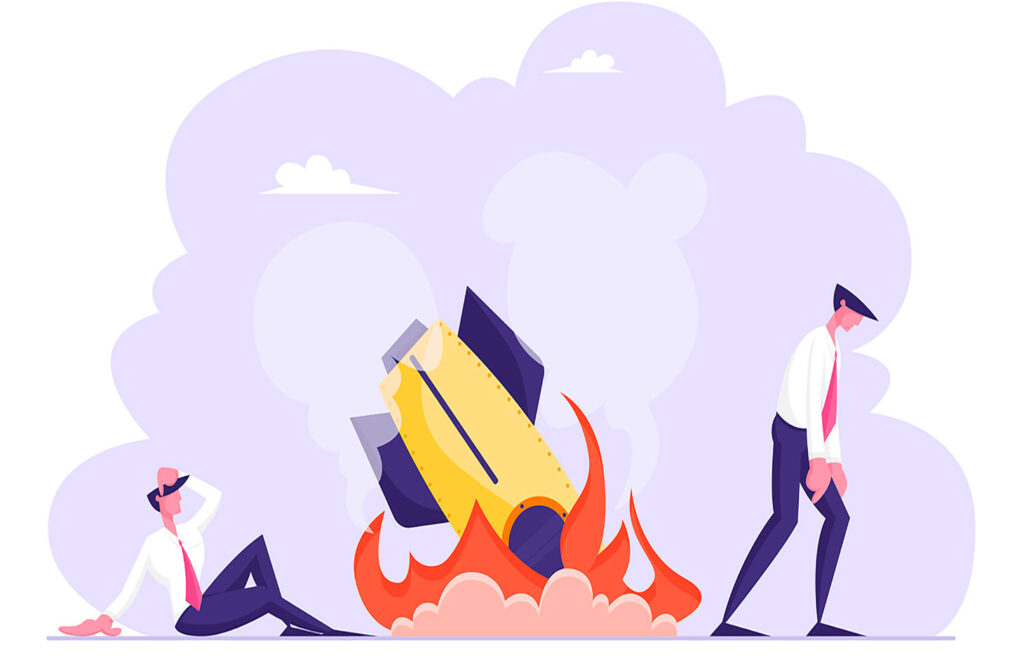You’re a rapid-growth SaaS business, growing…well, rapidly. And you want to grow more, so expanding your sales team is a natural next move. You want people who will move your product no matter what it takes, right?
Perhaps not.
High sales volume is good. Indiscriminate selling is not. Beware the churn and burn, where salespeople hunt leads ferociously, but with little regard for who they’re selling to or how they close the deal.
Granted, high-volume selling has its appeal. What subscription business doesn’t want quick growth and high, predictable revenue? Ethical considerations notwithstanding, however, the churn and burn sales strategy can be ruinous to a growing SaaS company.
How it hurts the subscription business model
Consider the mechanics of the subscription business model. Most SaaS products exist within a crowded marketplace. Often, customer experience is one of the biggest factors that distinguishes one business from another.
In fact, 80% of SaaS customers say their experience is just as important as the product itself, while 64% say the experience is more important than the price.
When a customer isn’t happy, the subscription model makes it easy to seek a new vendor—thanks both to high levels of competition and the ease of canceling a contract. True recurring revenue is built by business models that prioritize long-term customer relationships.
The problem with using churn and burn as a strategy is that it disregards ideal customer personas (ICPs), onboarding, and customer experience (CX) in favor of casting as wide a net as possible. You might bring a lot of customers in for the short term, but the long-term damage far outweighs the benefit. When your sales team churns and burns, your business:
- Undermines consumer confidence: Subscription companies with a reputation for misrepresenting themselves are destined to be blacklisted eventually. As Warren Buffet said, “It takes twenty years to build a reputation, and five minutes to ruin it.”
- Loses Money: It sounds paradoxical, almost. How could increasing your customer count cost you revenue? In the subscription economy, customers that only stick around for a month or two often pose more problems than benefits. It’s all about recovering your customer acquisition cost (CAC). It can take a long time to realize a profit from a new customer. This is especially true with large accounts. A churn and burn strategy rarely gives you enough time to recuperate customer acquisition costs, let alone turn a profit.
- Misses out on great customers: By taking a buckshot approach, your sales staff may be costing you loyal customers who stick around longer and spend more. One loyal customer who stays for years and goes in for upgrades and upsells is worth considerably more than several who cut out after one month.
Subscription model resources go to waste on the bad-fit customer
While your sales staff learns bad habits and your customers find themselves reconsidering their options, your churn and burn strategy continues in its destructive ways.
The more ill-suited customers you sign, the more wasted your resources will be. Why?
Because if you’re like most SaaS businesses, your customer contact does not begin and end with a sale. You also have onboarding and customer success. SaaS companies spend tens of thousands of dollars each year on their onboarding efforts. They also spend up to 10% of their revenue on marketing, and (potentially) many thousands of dollars on customer success management.
While these investments can be a great way to lock in monthly subscriptions and solidify annual recurring revenue, they’re largely wasted on a business strategy that doesn’t prioritize keeping customers around for the long haul.
To secure future growth, and ensure financial health, SaaS businesses are well advised to develop a strategy that caters to customer-centric business goals. The good-fit customer spends more, stays around longer, and sincerely benefits from your product.
How subscription businesses can eliminate bad sales habits
To maximize a customer’s lifetime value, modern software businesses must emphasize a sales strategy that focuses on quality over quantity. A small but loyal customer base is typically more beneficial than a large, displeased one.
By emphasizing the right things, you can make it much easier for your sales team to adopt strategies that benefit themselves, your business, and the customers.
Focus on training
Churn and burn is not always a deliberate strategy. Sometimes, your sales team may misrepresent your product simply because they don’t fully understand it themselves.
Factor in that most subscription companies release significant new features in their product every six months, and it becomes clear how even a well-meaning salesperson might be liable to misrepresent or misunderstand their own offerings. Software as a service businesses may find it beneficial to conduct sales training on a recurring basis—especially when it comes time for an update or feature upgrade.
Of course, training needn’t only be limited to product education. Sessions should also be used to describe how you expect your sales team to acquire customers.
Your staff may be so focused on sales channels and maximizing the revenue stream in the short term that they overlook other key metrics.
Demonstrate that you prioritize building good customer relationships and achieving a high customer lifetime value and your sales team will begin to understand the importance of these factors for a successful subscription business.
Emphasize long-term contracts
The average salesperson’s interests might inherently favor a quick turnaround over long-term monthly fee collections. However, this can be overcome by placing a bigger emphasis on lengthy contracts that are more favorable to the subscription-based business model.
Long-term contracts tend to boost monthly recurring revenue by lowering rates of churn. In fact, annual contracts have significantly lower rates of churn than their monthly counterparts because they encourage customers to stick around long enough to acclimate to the product.
The subscription pricing structure already often encourages long-term contracts by allowing customers to save money over time. A good pricing model coupled with the right training may incentivize sales to seek annual contracts that are more beneficial to monthly recurring revenue, even if they take more work to get.
Tracking sales
You may also find success in eliminating churn and burn behaviors by tracking key sales metrics. Core sales analytics might include conversion rates, revenue, expansion, and CLTV. Good automated billing platforms allow businesses to easily keep track of these important sales statistics.
By taking a granular look at what your sales reps are doing, you can see beyond mere acquisition numbers, and develop a deeper understanding of who is bringing in the most long-term value.
Reconsider the way you incentivize
It’s also worth considering that your sales staff is being incentivized to churn and burn. When an employee is rewarded for customer acquisition above all else, they are ostensibly being advised to bring in as many customers as they can, with little regard for other factors.
The best way to adjust employee behavior may simply be to change their motivation. By determining commissions with factors that go beyond mere revenue, you ensure that your sales staff will be more mindful in how they approach leads. Establish rewards for customer retention, satisfaction, and high NPS scores, and you’ll ensure your sales staff’s priorities properly align with your own.
Creating a burn-free culture
Bad sales techniques go beyond simple misrepresentation. In an effort to get commissions, salespeople have been known to offer products at an overly discounted price. Stir in free trials and other strategies designed to lure in new customers with little regard for long-term customer relationships and it becomes clear the number of key metrics relevant to your revenue stream is multifaceted and complex.
New customers for your subscription service are great, but only when they’re the right customers. By rewarding quality over quantity and catering to good-fit customers, you build a stable foundation conducive to long-term business growth.
Quick FAQs about Churn and Burn Sales
Q: What is a churn and burn sales strategy?
A churn and burn sales strategy refers to a high-volume selling approach where salespeople aggressively pursue leads, often with little consideration for the ideal customer persona or the quality of customer experience. This approach may result in a short-term increase in customer count, but can be harmful to the business in the long run due to its potential to undermine consumer confidence, increase customer churn, and result in loss of revenue.
Q: How does churn and burn sales strategy impact a subscription business?
A churn and burn sales strategy can be detrimental for a subscription business. It can undermine consumer confidence, leading to the business being blacklisted. It can also lead to financial losses as customers acquired through this strategy often don’t stick around long enough for the business to recuperate customer acquisition costs or turn a profit. Moreover, it may result in missing out on potential loyal customers who could have provided more long-term value.
Q: Why is customer experience important in a subscription business?
Customer experience is crucial in a subscription business as it is often one of the major factors that distinguish one business from another in a crowded marketplace. A good customer experience can lead to longer customer retention, higher customer satisfaction, and potentially, increased revenue.
Q: What is the downside of focusing solely on customer acquisition?
Focusing solely on customer acquisition, particularly through a churn and burn sales strategy, can lead to short-term growth but can be damaging in the long run. It can result in attracting customers who don’t fit the ideal customer persona, leading to higher churn rates. It can also impact customer trust and brand reputation, and may not allow for sufficient recovery of customer acquisition costs.
Q: How can a subscription business avoid the pitfalls of a churn and burn sales strategy?
A subscription business can avoid the pitfalls of a churn and burn sales strategy by prioritizing quality over quantity in their sales approach. This includes focusing on building long-term customer relationships, identifying and catering to the ideal customer persona, and emphasizing customer experience. Regular sales training, particularly on product understanding and customer acquisition expectations, is also beneficial. In addition, the business can incentivize sales staff to seek long-term contracts and prioritize customer retention and satisfaction.
Q: How does a churn and burn strategy affect customer acquisition cost (CAC)?
A churn and burn strategy can increase the customer acquisition cost (CAC) because customers acquired this way often do not stick around long enough for the business to recover the CAC. Since the strategy emphasizes quantity over quality, many customers may not be a good fit for the product or service, leading to higher churn rates and lower customer lifetime value.
Q: How does a churn and burn strategy impact customer lifetime value (CLTV)?
A churn and burn strategy often leads to lower customer lifetime value (CLTV) because it tends to attract customers who are not a good fit for the product or service, leading to higher churn rates. These customers are less likely to stick around for the long term, which reduces the total revenue the business can earn from them over their lifetime as customers.








